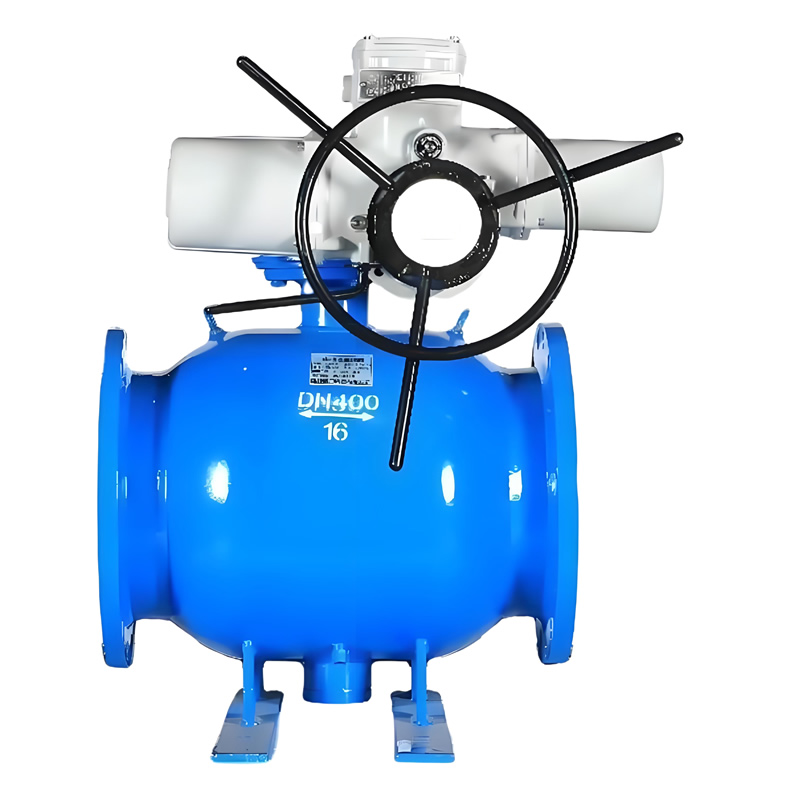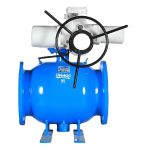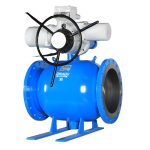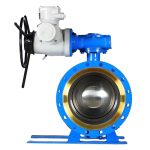TIANYU DN125-DN500 Electric Flanged Ball Valve: PTFE-Sealed, API 6D-Compliant Flow Control Solution for Oil, Water, and Steam Industrial Pipelines
I. Product Overview
II. Key Attribute Specifications
A. Dimensional & Pressure Parameters
- Nominal Diameter (Port Size): DN125 to DN500 (5 inches to 20 inches), covering the critical range of large-diameter low-pressure industrial pipelines. The full-port design (where the ball’s bore matches the pipeline inner diameter) minimizes pressure drop, with a flow coefficient (Cv) ranging from 250 (DN125) to 2800 (DN500). This ensures efficient media transfer—for example, a DN500 valve can handle up to 1500 m³/h of water at 20℃, meeting the flow needs of municipal water mains or industrial cooling circuits.
- Pressure Rating: PN0.6MPa (0.6MPa), PN1.0MPa (1.0MPa), and PN1.6MPa (1.6MPa) (low-pressure classification per industrial standards). Hydrostatic testing adheres to API 598: 1.5×rated pressure for the valve shell (e.g., 2.4MPa for PN1.6) and 1.1×rated pressure for the seat (e.g., 1.76MPa for PN1.6), with no leakage or structural deformation allowed.
- Temperature Range: -30℃ to 200℃ (converted from the product’s -22℉ to 284℉), enabled by PTFE seals and compatible body materials. This range covers ambient media (water, oil), moderately heated steam (saturated steam up to 180℃), and low-temperature industrial fluids (e.g., chilled water).
B. Material Composition
- Valve Body:
- Cast Iron (HT200): Cost-effective for non-corrosive, low-pressure applications (PN≤0.6MPa) such as municipal water supply. It offers tensile strength of 200MPa and good machinability, with a painted surface to resist atmospheric corrosion.
- Cast Steel (WCB, ASTM A216): Suitable for medium-pressure industrial use (PN≤1.6MPa) and moderately corrosive media (e.g., hot water, light oil). With tensile strength of 485–655MPa and yield strength of ≥240MPa, it withstands thermal stress and minor pressure fluctuations.
- Stainless Steel (304/316, ASTM A182): Recommended for corrosive environments (e.g., seawater, chemical solutions). 304 stainless steel (18Cr-8Ni) resists mild acids and chlorides, while 316 stainless steel (16Cr-10Ni-2Mo) enhances resistance to sulfides and aggressive chemicals—ideal for petrochemical or marine applications.
- Ball:
- Carbon Steel (1045): For general service with non-corrosive media, often coated with epoxy to improve wear resistance and prevent rust.
- Bronze: Offers excellent corrosion resistance in water and steam, suitable for HVAC or marine pipeline systems where copper alloys are preferred.
- Stainless Steel (304/316): Matches the valve body material for corrosive applications, ensuring uniform durability and preventing galvanic corrosion between components.
- Plastic (Reinforced POM): Lightweight option for low-pressure, non-toxic media (e.g., drinking water), with good chemical inertness and low friction.
- Sealing System:
- PTFE (Polytetrafluoroethylene): Standard seal material, featuring chemical inertness to most acids, alkalis, oils, and steam. It maintains elasticity at -30℃ to 200℃, delivering ANSI/FCI Class VI leakage performance (≤0.1×DN mm³/min) for bubble-tight sealing.
- Backup Metal Seal (Optional): Stellite 6 (cobalt-based alloy) for high-temperature or abrasive media (e.g., steam with fine particles), ensuring seal integrity even if PTFE degrades under extreme conditions.
- Electric Actuator:
- Housing: Aluminum alloy (6061-T6) with epoxy powder coating, rated IP67 for dust and water immersion—suitable for outdoor or damp industrial environments (e.g., wastewater plants, power plant cooling towers).
- Internal Components: 304 stainless steel drive shaft (resists corrosion), POM (polyoxymethylene) gears (low friction, quiet operation), and brass electrical connectors (reliable conductivity).
- Power & Torque: Available in AC220V, AC380V, or DC24V; torque output ranges from 80N·m (DN125) to 3000N·m (DN500) to match valve size and pressure, ensuring smooth 90° rotation for on-off control.
C. Connection & Operational Features
- Connection Type: Flanged (Raised Face, RF) as primary, complying with ASME B16.5 (USA) and GB/T 9115.1 (China). NPT threaded connections are optional for small diameters (DN125–DN200) in low-pressure systems. The RF flange design enhances gasket compression, compatible with spiral-wound gaskets (stainless steel + graphite) for high-temperature service or non-asbestos gaskets for general use.
- Operation Mode:
- Electric Control: 90° rotation for on-off control; adjustable cycle time (10–60 seconds) via built-in flow control valves. Modulating control (0–100% opening) is available with a 4–20mA analog signal, enabling precise flow regulation (e.g., adjusting oil flow in chemical reactors).
- Manual Override: Mechanical handwheel for emergency operation during power outages—critical for safety-critical systems (e.g., steam lines in power plants) to prevent media overflow.
- Position Feedback:
- Analog: 4–20mA signal (matches valve opening percentage) for integration with SCADA/DCS systems (e.g., Siemens SIMATIC, Allen-Bradley ControlLogix).
- Digital: Modbus RTU protocol for remote monitoring of valve status (open/closed, fault alerts) and parameter adjustment (torque limits, cycle time).
- Safety Features:
- Thermal Overload Protection: Triggers at 120% of rated torque to prevent motor burnout (e.g., if the ball jams due to pipeline debris).
- Phase Loss Protection: Shuts down the actuator if AC power phases are unbalanced, avoiding electrical damage.
- Explosion-Proof Option (ATEX/IECEx Ex d IIB T3): For hazardous areas (e.g., oil refineries, gas storage facilities) where flammable vapors may be present.
D. Certifications & Compliance
- Core Certifications: ISO 9001 (quality management system), CE (EU safety compliance for machinery), and GB/T 19001 (Chinese quality standard).
- Industry-Specific Certifications: API 6D (pipeline ball valves) for oil/gas applications, ensuring compliance with pipeline safety requirements (e.g., pressure testing, material traceability). NACE MR0175/ISO 15156 is optional for sour service (H₂S-containing media), using 316 stainless steel to resist sulfide stress cracking.
- Dimensional Compliance: ASME B16.34 (valve pressure-temperature ratings), GB/T 12237 (ball valve design), and MSS SP-97 (flange end dimensions), ensuring compatibility with pipeline components from global manufacturers.
III. Feature Description
A. Electric Actuation: Automation & Remote Control for Industrial Efficiency
B. Flanged Connection: Leak-Tight Integrity & Easy Maintenance
- Leak Resistance: The RF flange and gasket create a uniform seal even under pressure fluctuations. In a petrochemical plant’s DN300 oil line, TIANYU’s flanged valves showed zero leakage after 3 years of service, while threaded valves required quarterly gasket replacements due to vibration-induced loosening.
- Simplified Maintenance: Flanges allow the valve to be removed from the pipeline without cutting, reducing maintenance downtime by 70% compared to welded valves. For example, replacing a worn PTFE seal in a DN200 valve takes 2 hours with flanged connections, versus 8 hours for welded valves (which require cutting, re-welding, and pressure testing).
- Scalability: Standard flange dimensions (ASME B16.5) enable easy retrofitting into existing pipelines. A power plant upgrading its cooling water system, for instance, could replace old gate valves with TIANYU’s flanged ball valves without modifying pipeline flanges.
C. PTFE Sealing: Chemical Inertness & Bubble-Tight Performance
- Chemical Inertness: Resists attack from 95% of industrial chemicals, including sulfuric acid (50%), sodium hydroxide (30%), and crude oil. In a chemical plant’s DN150 acid line, PTFE-sealed valves maintained sealing integrity for 4 years, while rubber seals degraded within 6 months.
- Low-Temperature Stability: Remains flexible at -30℃, making it suitable for chilled water systems (e.g., food processing plants cooling fruit juices). Unlike rubber seals, PTFE does not harden or crack in cold conditions, ensuring consistent leakage performance.
- High-Temperature Tolerance: Withstands up to 200℃, compatible with saturated steam (180℃, PN1.0MPa) in power plant auxiliary systems. The seal’s low friction (coefficient ≤0.04) also reduces actuator torque requirements, extending motor life by 30%.
D. Floating Ball Design: Pressure Adaptability & Structural Stability
- Pressure-Enhanced Sealing: When media flows, pressure pushes the ball against the downstream PTFE seat, creating a tighter seal as pressure increases. This ensures ANSI/FCI Class VI leakage even at minimum operating pressure (PN0.6MPa), critical for low-pressure water lines where seal pressure is limited.
- Radial Stress Reduction: The floating design eliminates radial movement of the ball under high pressure (PN1.6MPa), reducing wear on seats and extending seal life by 50% compared to trunnion-mounted balls in low-to-medium pressure applications.
- Simplified Construction: Fewer components than trunnion-mounted valves reduce manufacturing complexity and cost, making the floating ball design a cost-effective choice for DN125–DN500 low-pressure systems (e.g., municipal water, HVAC).
E. Material Versatility: Adaptation to Diverse Industrial Media
- Water & Wastewater: Cast iron (HT200) or WCB bodies with PTFE seals handle potable water and sewage. The cast iron’s painted surface resists rust in buried pipelines, while PTFE resists corrosion from chlorine-based disinfectants.
- Oil & Gas: 316 stainless steel bodies with PTFE seals regulate crude oil and natural gas flow. 316’s molybdenum content resists chloride corrosion (e.g., seawater in offshore pipelines), while PTFE prevents oil leakage.
- Steam & HVAC: WCB bodies with PTFE seals control saturated steam (≤180℃) in power plants and commercial buildings. WCB’s thermal stability withstands steam temperature cycles, and PTFE’s low friction ensures smooth valve operation.
- Chemicals: 316 stainless steel bodies with PTFE seals handle acids and alkalis. PTFE’s chemical inertness prevents media contamination, making it suitable for pharmaceutical or food-grade chemical lines.
IV. Manufacturing Processes
A. Material Inspection & Preparation
- Raw Material Verification:
- Metallic Materials: Cast iron (HT200), WCB, and 304/316 stainless steel billets undergo spectral analysis to confirm chemical composition (e.g., C: 0.25–0.35% for WCB, Cr: 18–20% for 304). Ultrasonic testing (UT) detects internal defects (porosity, cracks) in cast components, ensuring structural integrity under pressure.
- Plastic Materials: Reinforced POM balls are tested for tensile strength (≥60MPa) and impact resistance (≥10kJ/m²) to ensure durability in low-pressure applications.
- Seal Materials: PTFE sheets are tested for compression set (≤20% after 70 hours at 200℃) and chemical resistance (immersion in 50% sulfuric acid for 100 hours with no weight loss >1%).
- Surface Preparation:
- Cast components are sandblasted to remove scale and surface defects, improving paint adhesion (for cast iron) or passivation (for stainless steel). Stainless steel components undergo acid passivation to enhance the chromium oxide passive layer, boosting corrosion resistance.
- PTFE seals are precision-cut to match the ball’s curvature, with a tolerance of ±0.05mm to ensure uniform contact.
B. Valve Body & Ball Machining
- Valve Body Machining:
- CNC turning centers shape the valve body, with flange faces machined to a flatness tolerance of ≤0.05mm/m and surface finish of Ra ≤3.2μm—critical for proper gasket seating. Internal seat pockets are honed to a diameter tolerance of H7 (0–+0.03mm) to fit PTFE seals snugly.
- Flow channels are machined to full-port dimensions, minimizing pressure drop. For DN500 bodies, the flow channel diameter is matched to the pipeline inner diameter (508mm for 20-inch), ensuring unobstructed media flow.
- Ball Machining:
- Balls are CNC-turned to a spherical tolerance of ±0.02mm, then lapped to a surface roughness of Ra ≤0.8μm using diamond abrasive. This precision ensures uniform contact with PTFE seals, delivering low leakage.
- Metallic balls (carbon steel, stainless steel) undergo heat treatment: carbon steel balls are quenched and tempered (850℃ quenching, 550℃ tempering) to achieve hardness of 28–32 HRC, while stainless steel balls are solution-annealed (1050℃ for 30 minutes) to restore corrosion resistance.
- Plastic balls (reinforced POM) are injection-molded, then CNC-trimmed to remove flash and ensure dimensional accuracy.
C. Actuator Integration & Calibration
- Actuator Assembly:
- The actuator’s gearbox is assembled in a cleanroom to prevent dust contamination. Gears are lubricated with synthetic grease (temperature range: -40℃ to 150℃) to reduce friction and noise.
- The motor and control board are wired to the electrical connector, with insulation resistance tested to ≥100MΩ at 500V DC to prevent electrical shorts.
- Valve-Actuator Integration:
- The actuator is mounted to the valve via an ISO 5211 adapter flange—standard for valve-actuator compatibility. The actuator’s drive shaft is connected to the valve stem via a spline coupling, ensuring torque transmission without slippage.
- Laser alignment tools confirm coaxiality between the actuator and valve stem (runout ≤0.05mm), preventing binding during operation.
- Calibration:
- Torque Calibration: A torque tester adjusts the actuator’s output to match the valve’s requirements (e.g., 80N·m for DN125 PN0.6). Overload protection is set to 120% of rated torque (e.g., 96N·m for DN125) to prevent motor damage.
- Position Calibration: The 4–20mA feedback signal is calibrated to ensure 0mA corresponds to fully closed and 20mA to fully open, with a hysteresis of ≤1% for precise control.
D. Quality Testing & Certification
- Hydrostatic Testing:
- Shell Test: The valve body is filled with water and pressurized to 1.5×rated pressure (e.g., 2.4MPa for PN1.6) for 30 minutes. No leakage, sweating, or deformation is allowed—test results are documented in a hydrostatic test report.
- Seat Test: The valve is closed, and water is pressurized to 1.1×rated pressure (e.g., 1.76MPa for PN1.6) on the inlet side. Leakage is measured using a flow meter, with results required to meet ANSI/FCI Class VI.
- Operational Testing:
- The valve undergoes 100 open-close cycles with electric actuation to verify smooth operation. Torque is recorded at each cycle to ensure consistency (variation ≤5%).
- Manual override is tested to confirm it can fully open/close the valve within 20 turns (for DN500), even if the actuator fails.
- Environmental Testing:
- The actuator is subjected to IP67 testing (immersion in 1m of water for 30 minutes) to confirm dust and water resistance. Explosion-proof actuators undergo additional testing per ATEX/IECEx standards (e.g., flameproof enclosure testing to prevent ignition of external flammable vapors).
- Certification Documentation:
- Each valve is accompanied by a Material Test Report (MTR) for all metallic components, a hydrostatic test report, and compliance certificates (ISO 9001, CE). API 6D-certified valves include additional documentation (e.g., pressure-temperature rating tables, fire test reports if applicable).

V. Product Advantages
A. Energy Efficiency & Cost Savings
B. Labor Savings & Automation
C. Long Service Life & Low Maintenance
D. Leak-Tight Performance & Safety
E. Global Compatibility & Compliance
VI. Product Applications
A. Municipal Water Supply & Wastewater
- Water Distribution Networks: DN125–DN500 cast iron (HT200) or WCB valves with PTFE seals control flow in municipal water mains. Electric actuation allows remote adjustment of flow rates to match demand (e.g., increasing flow during morning peak hours), reducing water hammer and pipeline damage.
- Wastewater Treatment Plants: DN125–DN300 316 stainless steel valves with PTFE seals regulate flow in sewage collection and treatment lines. 316’s corrosion resistance withstands chlorine-based disinfectants, while PTFE’s chemical inertness prevents seal degradation from organic matter.
B. Oil & Gas Industry
- Crude Oil Pipelines: DN200–DN500 316 stainless steel valves with PTFE seals control crude oil flow in refineries. The PTFE seals prevent oil leakage, while the electric actuator’s Modbus communication enables real-time flow monitoring. Optional explosion-proof actuators (ATEX Ex d IIB T3) are used in Zone 1 hazardous areas (e.g., oil storage tanks).
- Natural Gas Distribution: DN125–DN300 WCB valves with PTFE seals regulate natural gas flow in municipal or industrial gas lines. The full-port design minimizes pressure drop, ensuring efficient gas delivery, and PTFE’s low friction ensures smooth valve operation.
C. Power Generation
- Thermal Power Plants: DN300–DN500 WCB valves with PTFE seals control cooling water flow in condenser circuits. The valves’ low pressure drop reduces pump energy consumption, while electric actuation integrates with the plant’s DCS system for automated load balancing. Manual override ensures emergency shutdown during power outages.
- HVAC Systems: DN125–DN200 cast iron valves with PTFE seals regulate hot/cold water flow in commercial buildings (e.g., shopping malls, hospitals). The electric actuator’s 4–20mA signal enables precise temperature control, reducing energy costs for heating/cooling.
D. Chemical Processing
- Basic Chemical Plants: DN125–DN300 316 stainless steel valves with PTFE seals handle acids (e.g., sulfuric acid) and alkalis (e.g., sodium hydroxide). PTFE’s chemical inertness prevents media contamination, while 316’s corrosion resistance ensures long service life. Modulating control allows precise dosing of chemicals in reactors.
- Pharmaceutical & Food-Grade Chemicals: DN125–DN200 electropolished 316L stainless steel valves with PTFE seals handle high-purity chemicals (e.g., pharmaceutical intermediates). The electropolished surface (Ra ≤0.4μm) prevents bacterial growth, meeting GMP (Good Manufacturing Practice) requirements.
E. Food & Beverage
- Beverage Production: DN125–DN200 304 stainless steel valves with PTFE seals control water and syrup flow in soft drink or beer breweries. 304’s corrosion resistance and PTFE’s food-grade compliance (FDA 21 CFR 177.1550) ensure product safety. The full-port design prevents fluid stagnation, reducing the risk of contamination.
- Dairy Processing: DN125–DN150 316L stainless steel valves with PTFE seals regulate milk and cream flow. 316L’s resistance to lactic acid and PTFE’s easy cleaning (smooth surface) meet dairy industry hygiene standards.
RELATED
-

High Temperature/Pressure 304 Stainless Steel Resistant Manual Power Forged Three Piece Flanged Floating Ball Valve
TIANYU 304 Stainless Steel Flanged Floating Ball Valve: Corrosion-Resistant Full-Port Flow Control Solution for Industrial, Sanitary, and Municipal Me…
BALL VALVE 11/03/2025 -

API ANSI 2in-16in DN50-DN400 PN10 PN16 CF8M Pneumatic Flanged Floating Ball Valve
TIANYU CF8M Pneumatic Flanged Floating Ball Valve: 2in-16in (DN50-DN400) PN10-PN16 API/ANSI Class Corrosion-Resistant Flow Control Solution for Indust…
BALL VALVE 11/01/2025 -

Large-Diameter DN1400 CLASS150 WCB SS Triple Eccentric Metal-Sealed Hard Seal Butterfly Valve
TIANYU DN1400 (56″) CLASS 150 WCB Hard Seal Butterfly Valve: Triple Eccentric Metal-Sealed Flanged Valve for Large-Diameter Industrial Media wit…
BUTTERFLY VALVE 10/30/2025 -

PN16 Stainless Steel Floating Ball Valve: Full Port 2PC Flange-Connected Valve with Fire-Safe & Anti-Static SS Ball Valve
TIANYU Stainless Steel Floating Ball Valve: Full Port 2PC Flange-Connected Valve with Fire-Safe & Anti-Static Design for Oil, Gas, and Industrial …
BALL VALVE 10/29/2025 -

High-Performance DN80 Class 150 WCB Soft-Sealed Lug-Type Double Eccentric Butterfly Valve
TIANYU 3” Class 150 WCB lug-type double eccentric butterfly valve is a technologically advanced flow control device engineered to address the challeng…
BUTTERFLY VALVE 10/25/2025 -

DN125 PN16 CF8M Stainless Steel Lug-Type Butterfly Valve with PTFE Lining Concentric Line Butterfly Valves
TIANYU DN125 PN16 CF8M stainless steel lug-type butterfly valve is a precision-engineered flow control device designed to address the challenges of ha…
BUTTERFLY VALVE 10/25/2025






